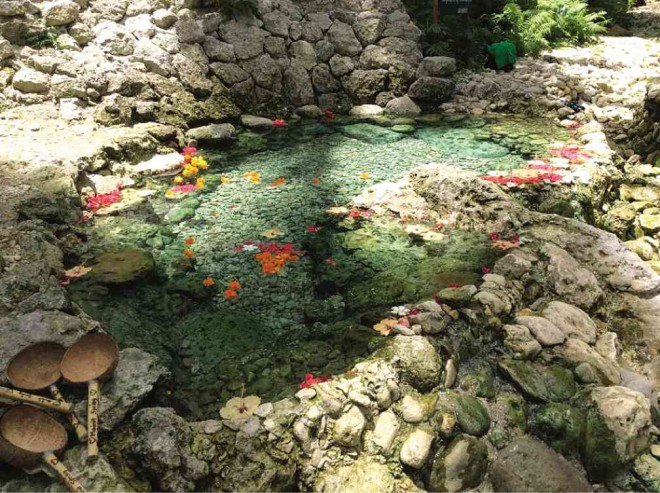Malabuyoc’s hot springs

ONE OF THE pools at Mainit Springs in Malabuyoc town in Cebu province CARMEL LOISE MATUS/ INQUIRER VISAYAS
There is a new tourist attraction in this sleepy town, some 126 kilometers south of Cebu City.
Mainit Springs in Barangay Montaneza has become a refreshing alternative to beaches that the neighboring towns of Moalboal, Badian and Alegria are known for.
The Malabuyoc municipal government, with the Department of Tourism (DOT) in Central Visayas, has packaged the hot springs as Cebu’s version of the onsen in Japan.
Onsen is a Nihongo term for hot springs where the Japanese believe that soaking in the warm water speeds up metabolism, massages the muscles, removes the aches, cleanses the skin, among other benefits.
Lolita Savilino, who lives near the hot springs, said that since she was 5, her neighbors would dip into the hot spring because of its health benefits.
Article continues after this advertisement“Many residents here have been cured of their skin diseases by taking a dip in the hot spring,” said Savilino, now 57.
Article continues after this advertisement“Whenever we have cough or fever, we would dip into the hot spring. The hot water and the steam would give us relief. Then we would feel better,” she said.
Warm pools
Mainit Springs has three pools that have varying degrees of warmth.
The biggest pool has the hottest water temperature at 44 degrees Celsius and is at an elevated portion fronting the stone-and-bamboo stairway that leads to Montaneza River.
The second pool is smaller and has a lower temperature of 36 degrees. The smallest pool has a water temperature of 38 degrees. The two small pools are at the center of Montaneza River.
Steam comes out of the pool. The water is so clear that one can see rocks at the bottom.
According to the Philippine Institute of Volcanology and Seismology (Phivolcs), the warm water may be caused by hot volcanic rocks underneath Montaneza River.
There could be a magma chamber underneath the river system that heats the water that passes through it, said Robinson Giorgio, Phivolcs science research specialist for Central Visayas.
He said the heat source could also be a fault line connected to the nearby island of Negros Oriental where most geothermal plants are located.
The heat generated is too low for power generation but hot enough to be used for eco-tourism and domestic purposes, according to the Department of Energy (DOE) in its report on the Malabuyoc Geothermal Prospect Area.
Hot springs’ uses
The DOE report said the hot springs in Malabuyoc were ideal for spa resort development.
The report said the location of the hot springs was ideal since Malabuyoc is near other tourist attractions like resorts in Moalboal and Badian and dolphin sight-seeing spots at Tañon Strait on the Malabuyoc side.
The DOE also said the community enjoyed the luxury of electricity and potable water supply as well as communication facilities.
The DOE report was made in 2005 but it took eight years before the municipal government decided to organize the community that would run the eco-tourism destination.
Malabuyoc Mayor Lito Creus said he believed that if the residents would earn from the hot springs, they would take care of these.
Before the community was organized, empty packs of chips, candy wrappers and shampoo sachets littered the grounds near the hot springs.
A cement enclosure was also built in the bigger pool creating a smaller pool inside. The DOT removed the enclosure on June 18 last year.
To ensure that the natural treasures are well taken care of, residents were organized and trained as trek guides, masseurs and maintenance personnel.
Now, Mainit Ecotourism Association has at least 35 members, all residents of Sitio Mainit, Barangay Montaneza, who make a living from the tourism boom.
One of them is Savilino.
Savilino, a former housemaid in Manila, said she joined several seminars and training sessions organized by the DOT before she became part of the springs’ maintenance team.
The training has transformed her into a passionate advocate of the environment, she said.
Mainit Springs had a soft opening in August 2013, said Malabuyoc tourism officer Eric Ybas. An entrance fee of P20 is collected per tourist.